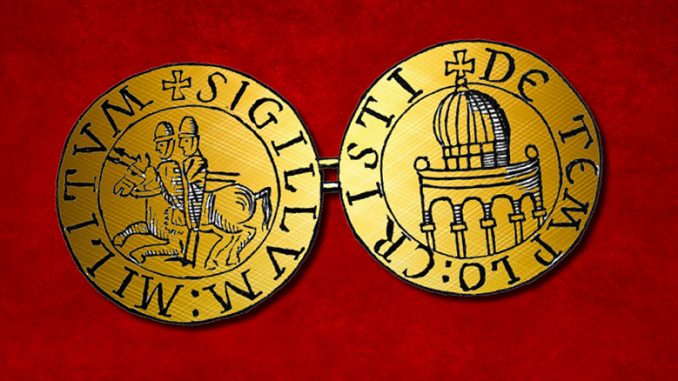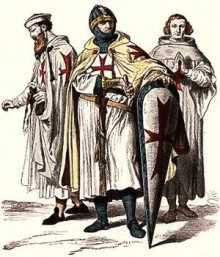
Templar Organizational Structure © 2001 by Salvatore T. Brunoo
This article will summarize the detailed analysis presented in my book, Templar Organization: the Management of Warrior Monasticism. I will describe the Templar Organizational Structure hierarchy of one of the most remarkable institutions of the medieval world; The Order of the Poor Knights of Christ of the Temple of Solomon in Jerusalem, (the Templars). This singular group was founded on the completely unique innovation of combining the triple monastic vows of chastity, poverty, and obedience, with the military vocation of knighthood. This concept was revolutionary (and not wholly embraced by the clergy of the day). Drawing from the best of both worlds, these men created a complex, highly disciplined crusader war machine that was altogether unique among its contemporary rivals. The effectiveness of this group impressed the most experienced and successful military leaders of the day. The monastic context allowed the Templars to achieve a very high degree of discipline and uniformity more commonly associated with modern military organizations. A study of their highly evolved organizational structure reveals a great deal about how they were able to achieve their successes.
This analysis of Templar Organizational Structure is primarily based on the French Rule (OF Rule) as translated into English by J. M. Upton-Ward. This amazing set of military regulations describes the responsibilities of the Order’s members in wartime and in peace. It evolved from the original “Primitive Rule” created by the Council of Troyes in 1129 over the entire 180-year history of the Order until its suppression by King Philip the Fair in the early 1300s.
It is important to view the Templars within the context of their secular contemporaries. Although the Templars were profoundly innovative in the vision of their founding, the basic organizational building blocks were a product of their secular environment. Members were well indoctrinated in the outside world before joining. The Rule clearly states that children were not to be admitted to the Order. Knights were to be raised and trained in the secular world at least until they had reached adulthood before being admitted into the Templars. Thus, the influence of the norms, social structure, and standard military tactics of medieval Europe was pervasive. With that in mind, let us start this analysis with a brief sketch of how that secular world operated. I’ll also discuss how the Templars contrasted with the secular world in subtle, but important ways.
The Central focus of military tactics in the medieval world was the heavy cavalry charge of a group of mounted knights. This was supported by the mounted sergeants (ignoble mounted soldiers) and prepared for by the infantry. Although Philippe Contamine’s research tells us that a typical army contained four to nine times as many infantrymen as mounted warriors, the medieval military mind was almost exclusively centered on the Knight, as its most devastating weapon.
Templar Organizational Structure
The secular Knight is, therefore, the fundamental element of interest for our discussion. The “Knight” was not an individual in this context. He was the central figure of a tactical and logistic unit. To avoid confusion, I refer to this concept as a “Lance”. A basic Lance was comprised as follows:
A Knight with a destrier (war horse). He rode a mule, palfrey, roncin, or such traveling mount to and from engagements. This kept his “main battle tank” fresh and ready for action.
A lightly armed squire to care for the destrier and equipment, typically riding a mule. One or two pack animals.
Wealthy knights might double or triple this entourage. Altogether, we have between two and five people and three to ten mounts per Lance. The romantic image of a lone errant knight is strictly a literary invention. A lone knight was generally a miserable figure, down on his luck, and extraordinarily vulnerable.
Ten to twenty knights formed a banner. Ten to twenty Banners would form a Squadron. Five to ten squadrons formed a “battle”, assuming that many troops were present. The battles were generally arranged in five groups; The Van, Left and Right Wings, the Center or Main Battle, and the Rear Guard. The size, distribution and character of these forces varied greatly. They were organized around the feudal lords who were called up or under hire. The detailed deployment of the forces while on campaign was a daily affair, arranged on an ad hoc basis. Not surprising, the equipment and logistical support (such as it was) was anything, but uniform. Managing the force and maintaining discipline must have been a Herculean task.
The Templars employed the same basic structure used by the secular armies, but did it with Prussian efficiency. A fundamental difference between the Templars and their secular counterparts was the submission of free will. This important characteristic of modern armies was not present in secular medieval forces. Secular knights tended to be very independent. They were responsible for their own gear, squires and upkeep, and were brought together on campaign only for a short time each year. Controlling them was difficult, at best. By contrast, Templars possessed a high degree of discipline and conformity. The concept of the monastic vow of obedience is that a monk should obey the instructions of his abbot as if he were obeying the Lord. The Rule further instructs that Brother Knights should obey the orders of the commanders set over them. The effect of the culture of obedience was that Templars were noted for maintaining formation and order under the most difficult situations.
Like all real armies in the field, the Templars often found themselves with other than ideal force levels. Unlike their secular counterparts, however, their structure and basic building block units remained relatively consistent. The Rule precisely specifies the equipment, mounts and personal staff of every member, from the Master right down to Brother Sergeants. It even provides for modifications when horses or squires are in shortage or abundance. The Rule also leads us to believe that Banners and Squadrons were standardized in composition. With all of the equipment and mounts belonging to the order and not the individual Knights (who took the vow of poverty), the Templars developed a centralized system for the supply and efficient distribution of these resources.
The Templars utilized the basic military model of the secular world from which they originated. Their ability to achieve discipline and uniformity, however, set them apart. As I will discuss below, the Templars were also available around the clock and all year round. This was also a very important distinction between them and their secular counterparts.
Viola! This is the actual organizational structure that was used with the minor exception that the post of Treasurer was combined with that of the Commander of the Land of Jerusalem (Rule 111). This was no doubt due to the physical proximity of the Commander to both the Order’s headquarters and the capital city of the Holy Land. The ultimate “product” of the Templars was the making of war on the enemies of the Christian States. The Marshal was in charge of this “product”. The three lands and eight Provincial Masters were the functional groups charged with raising revenue and the literal “care and feeding” of the Brothers when not on campaign.
This is an extraordinarily sophisticated structure for a medieval institution. Remember that the Matrix Model has only recently gained wide spread popularity in our own time. It is clearly the most complex of the choices available. It is also much more difficult to execute successfully, requiring many more choices to be made. The Templars seem to have adopted this model very early in their history. Their environment would have encouraged this from the start. Their mission was fighting in Outremer, but their resources were scattered throughout the Western Europe and the Near East. This created the need for a matrix structure. The monastic nature of the Order enabled its application. As a church organization, a unifying coherency of authority was implicit. Without a coherent chain of command, a matrix organization would rapidly fracture. Thus, we see the happy convergence of need with ability.
Even quick reviews of the Order’s accomplishments tell us that there is something extraordinary about this group:
• Over 170 years of successful military service in the Holy Land
• The Only (along with the Hospitallers) major standing army in the Frankish East
• Garrison and construction of many of the most important Christian fortifications
• Vast property holdings all over Europe
• A sophisticated, international banking system
• Interests in most Mediterranean and European industries
The analysis discussed above has shown that the Templar organizational structure was highly tuned to their complex and widely dispersed interests. Indeed, when we examine it against the standards of modern organizational theory, we find a sophisticated matrix structure, executed so well as to put many modern corporations to shame. What is more remarkable, however, is that this was achieved during the Middle Ages, when socioeconomic institutions were relatively primitive. Without breaking important interfaces to the secular world, the Templars evolved this very modern structure from a purely feudal origin.
The vision of Founder Hugh de Payens, a monastic military order, was the underlying moral compass. It guided the application of the Templars’ unique tools and abilities. The effectiveness of the secular socioeconomic system was greatly hampered by the fragmentation of authority, the absence of even a rudimentary chain of command, and the acute lack of a consistent cash flow. Hugh’s original vision overcame these shortfalls. He and his successors carried the Templars though more than a century and a half of unparalleled success. Their accomplishments are truly remarkable.
About the Author of Templar Organizational Structure: Salvatore (Tory) T. Bruno
Mr. Bruno is an executive at Lockheed Martin Corporation. He is currently the Vice President of Engineering for Lockheed Martin’s Missiles and Space Organization in Sunnyvale California. In this capacity, he is responsible for nearly 4000 engineers and scientists. He was also the Chief Engineer for one of the most successful major weapon systems in history; the U. S. Navy’s Fleet Ballistic Missile. He participates in several strategic study groups, examining the technical approaches and acquisition strategies required to carry various programs into the next century. Previously, Mr. Bruno has served as the Program Manager for several important rocket and missile programs. These ranged in size from a few million, to several hundreds of millions of dollars per year. He has received numerous professional and academic awards and is a respected member of the aerospace community.
About Us
We hope you enjoyed this article on Templar organizational structure.
TemplarHistory.com was started in the fall of 1997 by Stephen Dafoe, a Canadian author who has written several books on the Templars and related subjects.
Templar Organizational Structure is part of our Templar History Archives – Templar History
